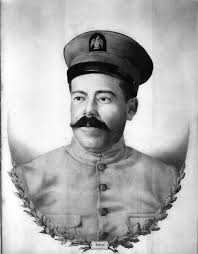In March 1914, one hundred years ago, Pancho Villa was reaching the pinnacle of his power. Images of Villa from this time show him in the uniform of a general. His ragged railroad car had given way to a series of cars for himself and his entourage. Constant companions were George Carothers, a diplomatic envoy of the U.S. government (who rode in his own rail car), a film crew, a personal doctor, and a group of foreign correspondents. Villa's Division of the North, an army of 40,000 men, controlled most of Northern Mexico. The might of the Villista army was nothing but astonishing given the fact that merely a year earlier, Villa had crossed the Rio Grande with a handful of companions to fight the murderer of President Francisco I. Madero. The trains not only carried his soldiers, artillery and horses. They also included an advance repair train to fix blown up bridges and ripped up rails. The most modern hospital train that even roused the admiration of the German military attaché Franz von Papen accompanied the soldiers into battle as well. Villa's supply organization was the best of all revolutionary forces. His soldiers donned American made uniforms and recent makes of Mauser 7 mm rifles. His artillery capabilities exceeded that of the federal army with modern Krupp cannon from Germany and captured French guns taken from the federal army. Since Felipe Ángeles, the former chief of the Colegio Militar (Mexico's West Point), had left Carranza's entourage and joined Villa as his chief military adviser, the Army of the North steamrolled the forces of President Victoriano Huerta. Already forced to give up the north of the country, Huerta's federal forces entrenched at Torreon, the strategic railway hub that connected northern and western Mexico with the capital.
On the 16th of March 1914, Villa’s army boarded the trains in Chihuahua and headed south. For the second time since 1911, Torreon stood between the revolutionary armies and Mexico City. With Felipe Ángeles in charge, Villa’s forces swooped into Gomez Palacio, severely beating the federal forces. On March 26th, the División Del Norte surrounded Torreon. The battle lasted a full week. Ángeles’ artillery supported 16,000 revolutionary soldiers who pummeled the city with a hail of fire night and day. Especially Villa’s famous night attacks caused the federal defenders to become demoralized and sleep deprived. They defected in droves. On April 2nd the city fell. Huerta had sent six thousand fresh reinforcements to nearby San Pedro de las Colonias to no avail. The newly established federal positions caved and what was left of the Huerta army withdrew to the south.
The sweeping victories of Villa's army depended to a large degree on supplies from the United States. Felix A. Sommerfeld, who through Sherburne G. Hopkins had contracted with Flint and Company to supply arms and munitions to the Villistas, was in charge of procuring the military supplies. Trainloads of arms and ammunition from Winchester, Remington, and Colt, arrived daily at the Mexican border where Sommerfeld's agents arranged the transfer to Villa's forces. Villa financed the effort with cattle confiscated from the large haciendas of Chihuahua and forced "taxes" from the merchants of towns he controlled. In New York the former head of Villa's treasury, Lazaro De La Garza and three uncles of the slain Mexican President Madero ran the financial organization. In Ciudad Juarez, Villa's brother Hipolito controlled the customs house, gambling joints, and cattle transfers. Despite the best efforts of Villa's supply organization and especially of Sommerfeld not everything went smoothly. Infighting and jealousies disturbed the teamwork. While Villa and his generals celebrated their success, Sommerfeld received severe admonishment from headquarters. Apparently, Flint and Company had sent bad ammunition. On April 14th, Villa ranted to Lazaro De La Garza:
PLEASE IMMEDIATELY solicit two million Mauser cartridges which must arrive within a short time to proceed with the campaign. I much recommend that you pay attention so that we may find no reason for such poor quality cartridges that Sommerfeld bought. I have lost my troops precisely because of not checking which is indispensable when buying this type of material.
The problems with Sommerfeld’s supplies worsened to the level where Villa was ready to fire him. Instead of De La Garza and the Maderos defending Sommerfeld, they stood by as their team member took fire. The general sent a telegram to De La Garza on May 30th in which he requested someone else to buy munitions. Of course, this was impossible since no one had the connections that the German agent had. The issue came to a head when De La Garza sent a stinging memo to Charles Flint on May 30th and signed it with Sommerfeld’s name:
Wired you yesterday seventy five thousand [.] Be sure goods ordered through Sommerfeld are new and thoroughly guaranteed, as failure of previous ones caused much damage and bad impression, but are giving you another chance to vindicate. – Ship Monday. – F.A. Sommerfeld
The next morning Sommerfeld asked Lazaro De La Garza whether he was out of his mind when he sent the earlier note to Charles Flint: De La Garza’s response has not been preserved.
You telegraphed Flint and Company yesterday that you are giving them another chance to vindicate themselves. I want to say that Flint has never sold us such merchandise before. Flint is a house of the highest standing and our friend who have [sic] given us advise [sic] and assistance many times. Your telegram is absolutely unjust and therefore I beg you to telegraph Flint telling them that your telegram was sent by mistake. F. A. Sommerfeld.
However, the shipments through Flint and Company from U.S. manufacturers proceeded unabashedly. Sommerfeld remained at his post. Within the next three months the embattled President of Mexico, Huerta, found himself thoroughly defeated and heading into exile to Spain.

